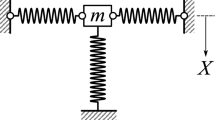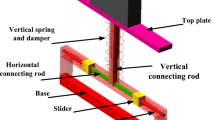Abstract
In this paper, an analysis is given about dynamic characteristics for a quasi-zero-stiffness isolator coupled with mechanical disturbance from a view of engineering application. In addition to traditional Columbo friction and linear damping in the vertical direction, the influence of other disturbing parameters such as geometrically nonlinear damping, friction and inertia of rods is also taken into consideration. The dynamic equation is formulated with parameters above to give an investigation of static characteristics, respectively, based on Newton’s second law and D’Alembert’s principle. Moreover, the frequency–amplitude response and transmissibility characteristics are obtained for this model subjected to the vibrating base by using average method with the introduction of piecewise function and then analyze the effect on the vibration response and isolation caused by disturbance. Furthermore, the passive vibration isolation simulation is conducted to verify the theorem. Therefore, it is recommended that the geometrically nonlinear damping can be introduced to the quasi-zero-stiffness system appropriately which can decrease the peak value of transmissibility in the low-frequency range, and nearly has no effect on the high-frequency region. And the mass of the rod should not be bigger than \(10^{-3}\) times of the isolator. The conclusions can provide engineering guidance for design and application about quasi-zero-stiffness system.

















Similar content being viewed by others
References
Molyneux, W.G.: The support of an aircraft for ground resonance tests: a survey of available methods. Aircr. Eng. Aerosp. Technol. 30, 160–166 (1958). https://doi.org/10.1108/eb032976
Carrella, A., Brennan, M.J., Waters, T.P., et al.: Force and displacement transmissibility of a nonlinear isolator with high-static-low-dynamic-stiffness. Int. J. Mech. Sci. 55, 22–29 (2012). https://doi.org/10.1016/j.ijmecsci.2011.11.012
Carrella, A., Brennan, M.J., Waters, T.P., et al.: Force and displacement transmissibility of a nonlinear isolator with high-static-low-dynamic-stiffness. Int. J. Mech. Sci. 322, 70–717 (2009). https://doi.org/10.1016/j.jsv.2008.11.034
Carrella, A., Brennan, M.J.: Static analysis of a passive vibration isolator with quasi-zero-stiffness characteristic. J. Sound Vib. 301, 678–689 (2007). https://doi.org/10.1016/j.jsv.2006.10.011
Thanh, D.L., Kyoung, K.A.: Active pneumatic vibration isolation system using negative stiffness structures for a vehicle seat. J. Sound Vib. 333, 1245–1268 (2014). https://doi.org/10.1016/j.jsv.2013.10.027
Thanh, D.L., Kyoung, K.A.: Experimental investigation of a vibration isolation system using negative stiffness structure. J. Sound Vib. 330, 6311–6335 (2011). https://doi.org/10.1016/j.ijmecsci.2013.02.009
Wang, X., Zhou, J., Xu, D., et al.: Force transmissibility of a two-stage vibration isolation system with quasi-zero stiffness. Nonlinear Dyn. 87, 633–646 (2017). https://doi.org/10.1007/s11071-016-3065-x
Li, Y., Xu, D.: Vibration attenuation of high dimensional quasi-zero stiffness floating raft system. Int. J. Mech. Sci. 126, 186–195 (2017). https://doi.org/10.1016/j.ijmecsci.2017.03.029
Li, Y., Xu, D.: Force transmissibility of floating raft systems with quasi-zero-stiffness isolators. J. Vib. Control 24, 3608–3616 (2018). https://doi.org/10.1177/1077546317708460
Wang, K., Zhou, J., Xu, D.: Sensitivity analysis of parametric errors on the performance of a torsion quasi-zero-stiffness vibration isolator. Int. J. Mech. Sci. 134, 336–346 (2017). https://doi.org/10.1016/j.ijmecsci.2017.10.026
Zhou, J., Xiao, Q., Xu, D., et al.: A novel quasi-zero-stiffness strut and its applications in six-degree-of-freedom vibration isolation platform. J. Sound Vib. 394, 47–59 (2017). https://doi.org/10.1016/j.jsv.2017.01.021
Tuo, J., Deng, Z., Zhang, H., et al.: A 3-axis torsion quasi-zero-stiffness-based sensor system for angular vibration measurement. J. Vib. Control 24, 4325–4336 (2017). https://doi.org/10.1177/1077546317724016
Tuo, J., Deng, Z., Huang, W., et al.: A six degree of freedom passive vibration isolator with quasi-zero-stiffness-based supporting. J. Low Freq. Noise Vib. Active Control 37, 279–294 (2017). https://doi.org/10.1177/1461348418756020
Cheng, C., Li, S., Wang, Y., et al.: Resonance response of a quasi-zero stiffness vibration isolator considering a constant force. J. Vib. Eng. Technol. 6, 471–481 (2018). https://doi.org/10.1007/s42417-018-0064-x
Su, P., Wu, J., Liu, S., et al.: A study of a nonlinear magnetic vibration isolator with quasi-zero-stiffness. J. VibroEng. 20, 310–320 (2018). https://doi.org/10.21595/jve.2017.18602
Valeev, A.: Dynamics of a group of quasi-zero stiffness vibration isolators with slightly different parameters. J. Low Freq. Noise Vib. Active Control 37, 640–653 (2018). https://doi.org/10.1177/1461348418756022
Zhou, Y., Chen, P., Mosqueda, G.: Analytical and numerical investigation of quasi-zero stiffness vertical isolation system. J. Eng. Mech. 145, 1–13 (2019). https://doi.org/10.1061/(ASCE)EM.1943-7889.0001611
Liu, X., Zhao, Q., Zhang, Z., et al.: An experiment investigation on the effect of Coulomb friction on the displacement transmissibility of a quasi-zero stiffness isolator. J. Mech. Sci. Technol. 33, 121–127 (2019). https://doi.org/10.1007/s12206-018-1212-7
Margielewicz, J., Gaska, D., Litak, G.: Evolution of the geometric structure of strange attractors of a quasi-zero stiffness vibration isolator. Chaos Solitons Fractals 118, 47–57 (2019). https://doi.org/10.1016/j.chaos.2018.11.012
Ding, H., Ji, J., Chen, L.: Nonlinear vibration isolation for fluid-conveying pipes using quasi-zero stiffness characteristics. Mech. Syst. Signal Process. 121, 675–688 (2019). https://doi.org/10.1016/j.ymssp.2018.11.057
Ding, H., Chen, L.: Nonlinear vibration of a slightly curved beam with quasi-zero-stiffness isolators. Nonlinear Dyn. 95(3), 2367–2382 (2019). https://doi.org/10.1007/s11071-018-4697-9
Cao, Q., Wiercigroch, M., Pavlovskaia, E.E., et al.: Archetypal oscillator for smooth and discontinuous dynamics. Phys. Rev. 74, 1–5 (2006). https://doi.org/10.1103/PhysRevE.74.046218
Cao, Q., Xiong, Y., Wiercigroch, M.: A novel model of dipteran flight mechanism. Int. J. Dyn. Control 1, 1–11 (2019). https://doi.org/10.1007/s40435-013-0001-5
Cao, Q., Wiercigroch, M., Pavlovskaia, E., et al.: Bifurcations and the penetrating rate analysis of a model for percussive drilling. Acta. Mech. Sin. 26, 467–475 (2010). https://doi.org/10.1007/s10409-010-0346-3
Tian, R., Cao, Q., Li, Z.: Hopf bifurcations for the recently proposed smooth-and-discontinuous oscillator. Chin. Phys. Lett. 27, 1–4 (2010). https://doi.org/10.1088/0256-307X/27/7/074701
Tian, R., Cao, Q., Yang, S.: The codimension-two bifurcation for the recent proposed SD oscillator. Nonlinear Dyn. 59, 19–27 (2010). https://doi.org/10.1007/s11071-009-9517-9
Han, Y., Cao, Q., Chen, Y., et al.: A novel smooth and discontinuous oscillator with strong irrational nonlinearities. Sci. China Phys. Mech. Astron. 55, 1832–1843 (2012). https://doi.org/10.1007/s11433-012-4880-9
Li, Z., Cao, Q., Wiercigroch, M., et al.: Analysis of the periodic solutions of a smooth and discontinuous oscillator. Acta. Mech. Sin. 29, 575–582 (2013). https://doi.org/10.1007/s10409-013-0061-y
Hao, Z., Cao, Q.: The isolation characteristics of an archetypal dynamical model with stable-quasi-zero-stiffness. J. Sound Vib. 340, 61–79 (2015). https://doi.org/10.1016/j.jsv.2014.11.038
Hao, Z., Cao, Q., Wiercigroch, M.: Nonlinear dynamics of the quasi-zero-stiffness SD oscillator based upon the local and global bifurcation analyses. Nonlinear Dyn. 87, 987–1014 (2017). https://doi.org/10.1007/s11071-016-3093-6
Hao, Z., Cao, Q.: A novel dynamical model for GVT nonlinear supporting system with stable-quasi-zero-stiffness. J. Sound Vib. 52, 199–213 (2014). https://doi.org/10.2140/jomms.2014.9.105
Mostaghel, N., Davis, T.: Representations of Coulomb friction for dynamic analysis. Earthq. Eng. Struct. Dyn. 26, 541–548 (1997). https://doi.org/10.1002/(SICI)1096-9845(199705)26:5<541::AID-EQE660>3.0.CO;2-W
Acknowledgements
The authors acknowledge the support from the major project of Natural Science Foundation of China under Grant No. 11732006.
Author information
Authors and Affiliations
Corresponding author
Ethics declarations
Conflict of interest
The authors declare that they have no conflict of interest.
Additional information
Publisher's Note
Springer Nature remains neutral with regard to jurisdictional claims in published maps and institutional affiliations.
This work was supported by the Natural Science Foundation of China (major program) under Grant No. 11732006.
Rights and permissions
About this article
Cite this article
Zhang, X., Cao, Q. & Huang, W. Dynamic characteristics analysis for a quasi-zero-stiffness system coupled with mechanical disturbance. Arch Appl Mech 91, 1449–1467 (2021). https://doi.org/10.1007/s00419-020-01832-x
Received:
Accepted:
Published:
Issue Date:
DOI: https://doi.org/10.1007/s00419-020-01832-x




